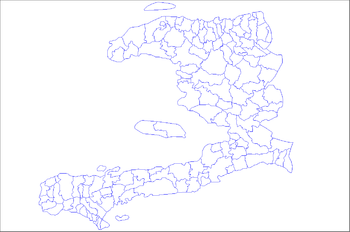Caracol, Nord-Est
| Caracol Karakòl | |
|---|---|
| Commune | |
 Caracol Location in Haiti | |
| Coordinates: 19°41′34″N 72°1′05″W / 19.69278°N 72.01806°WCoordinates: 19°41′34″N 72°1′05″W / 19.69278°N 72.01806°W | |
| Country |
|
| Department | Nord-Est |
| Arrondissement | Trou-du-Nord |
| Elevation | 3 m (10 ft) |
| Population (7 August 2003)[1] | |
| • Total | 6,236 |
Caracol (Haitian Creole: Karakòl) is a commune in the Trou-du-Nord Arrondissement, in the Nord-Est Department of Haiti. It has 6,236 inhabitants.
Caracol was a poverty-stricken fishing village on the north coast of Haiti. It was one of the poorest villages in the country.
Caracol Industrial Park
.jpg)
In 2012 the Caracol Industrial Park was built on a square mile, 600 acre, 252 hectare site near Caracol. The $300 million project, which was to include a 10-megawatt power plant, road, a water-treatment plant, worker housing in neighboring communities, and development of a port in nearby Fort-Liberté, was built with hurricane relief funds, a loan from the Inter-American Development Bank,[2] contributions by the United States government, and the Clinton Foundation.[3][4] As of 2013, only a 1.7-megawatt plant had been built.[5]
Prior to the 2010 earthquake, Bill Clinton was named special envoy to Haiti by UN Secretary General Ban Ki-Moon, whose connections with the South Korean company Sae-A Trading Co. Ltd were later put to work in the planning of the park.[6] On May 24, 2010, the Haiti Econcomic Lift Program (HELP) was signed into US law, ensuring preferential tariffs for Haitian-produced garments.[7] On October 22, 2012 Hillary Clinton gave the keynote speech as acting US Secretary of State for the opening of the industrial park.[6][8][9]
The anchor tenant is S & H Global, S.A, a subsidiary of Sae-A Trading Co. Ltd, a global clothing manufacturer headquartered in South Korea.[10][11] It began operations in the fall of 2012; a work force of 20,000 was projected.[12] The eventual workforce was projected to approach 65,000 and result in a tenfold expansion of population in the area to about 300,000 from its present 30,000. Social and environmental disruption is anticipated as the result of this hastily planned project.[11][12]
Since that time, factory conditions have become a source of significant criticism, particularly concerning living wages and housing.[5][6][12] Although the minimum wage was raised over US Embassy, US AID, and US State Department opposition,[13][14][15] garment factories across the country, including at Caracol Industrial Park, were not applying the law in late 2013.[5][16][17]
Communal Sections
The commune consists of two communal sections, namely:
- Champin, urban and rural, containing the town of Caracol
- Glaudine or "Jacquesil", rural
References
- ↑ Institut Haïtien de Statistique et d'Informatique (IHSI)
- ↑ "Haiti and its partners lay the foundation stone for the Caracol Industrial Park" (Press release). Inter-American Development Bank. November 28, 2011. Retrieved July 6, 2012.
- ↑ Katz, Jonathan (May 4, 2015). "The King and Queen of Haiti". Politico. Retrieved September 21, 2016.
- ↑ Katz, Jonathan (2013). The Big Truck That Went By: How the World Came to Save Haiti and Left Behind a Disaster. St. Martin's Press. ISBN 978-0-230-34187-6.
- 1 2 3 Claire Lauterbach; Elaine Zuckerman (2013). "Caracol Industrial Park Social and Gender Impacts of Year One of Haiti's newest IFI - funded Industrial Park" (PDF). GenderAction. Gender Action. p. 35. Retrieved September 23, 2016.
- 1 2 3 Johnston, Jake (January 16, 2014). "Outsourcing Haiti: How disaster relief became a disaster of its own". Boston Review. Retrieved September 22, 2016.
- ↑ "HR 5160: Haiti Economic Lift Program". govtrack. Retrieved 14 October 2016.
- ↑ Hillary Clinton (October 22, 2012). "Remarks at the Caracol Industrial Park Opening Ceremony". US Department of State. Retrieved September 23, 2016.
- ↑ Susana Ferreira; Andrew Quinn (22 October 2012). "Clintons preside at star-studded opening of Haitian industrial park". Reuters. Retrieved 14 October 2016.
- ↑ "New industrial park in Haiti" (Slide 4 of slideshow). The Miami Herald. Retrieved July 6, 2012.
- 1 2 Jacqueline Charles (June 4, 2012). "New industrial park in northern Haiti sparks controversy". The Miami Herald. Retrieved July 6, 2012.
- 1 2 3 Deborah Sontag (July 5, 2012). "Earthquake Relief Where Haiti Wasn't Broken". The New York Times. Retrieved July 6, 2012.
- ↑ CEPR staff (January 12, 2012). "Ten Things Cheryl Mills May Prefer You Not Know About Haiti Today". CEPR: Center for Economic Policy and Research. Retrieved September 23, 2016.
- ↑ Dan Coughlin; Kim Ives (June 1, 2011). "WikiLeaks Haiti: Let Them Live on $3 a Day". The Nation. Retrieved September 22, 2016.
- ↑ Dan Coughlin; Kim Ives (25 May 2011). "Washington Backed Famous Brand-Name Contractors in Fight Against Haiti's Minimum Wage Increase". Haiti Liberté. 4 (45). Retrieved September 22, 2016.
- ↑ Regan, Jane (December 3, 2013). "Wage Hike in Haiti Doesn't Address Factory Abuses". InterPress Service. Retrieved September 23, 2016.
- ↑ Katz, Jonathan (September 10, 2013). "A glittering industrial park in Haiti falls short". Al Jazeera. Retrieved September 23, 2016.
In fact, the question of minimum wage could be another drag on investors' interest. Under a recently enacted law, the minimum wage should now be roughly $6.85 a day for garment work. But factory owners have simply refused to pay the higher wages. A recent survey by the International Labor Organization found not a single factory in Haiti currently complying with the new law. Sae-A declined to comment on particulars, stating only that its employees "are compensated in accordance with local laws and regulations."
